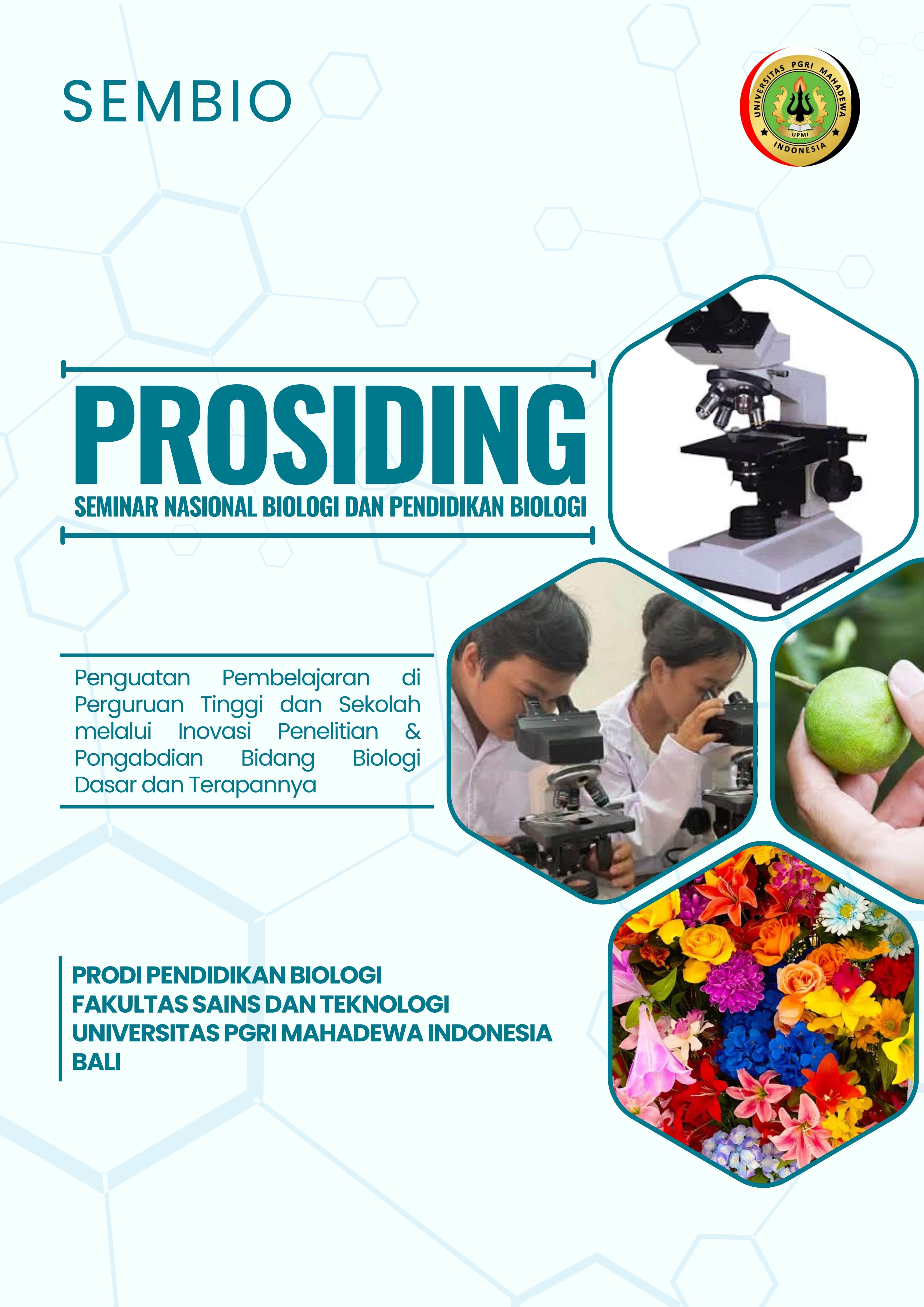TUMBUHAN FAMILI ZINGIBERACEAE DALAM UPAKARA DAN UPAYA PELESTARIANNYA DI DESA KEDISAN KECAMATAN TEGALLALANG KABUPATEN GIANYAR
DOI:
https://doi.org/10.59672/sembio.v3.4708Keywords:
Zingiberaceae, ritual, preservationAbstract
The Hindu community in Bali is inseparable from various religious ceremonies. In every religious ritual, the community uses multiple types of upakara facilities which are seen as a symbolic communication process carried out between humans and God, for all His gifts. Upakara facilities come from biodiversity, one of which comes from plants. Plants from the Zingiberaceae family known as empon-empon plants are one of the upakara facilities used in every Yadnya ceremony. Research related to this utilization was conducted in Kedisan Village, Tegallalang District, Gianyar Regency. Based on the research results, it is known that there are 14 types of plants from the Zingiberaceae family that are used in the ceremony, namely jahe (Zingiber officinale), kunyit kuning (Curcuma domestica Val.), kencur (Kaempferia galanga), kecombrang (Etlingera elatior), temu ireng (Curcuma aeruginosa), temu lawak (Curcuma xanthorrhiza), temu kunci (Boesenbergia rotunda), temu giring (Curcuma heyneane), temu mangga (Curcuma amada), temu tis (Curcuma purpurascen Blume), temu gongseng (Kaempferia rotunda L.), temu agung (Curcuma aromatica), temu putih (Curcuma zedoaria Rocs.), dan lempuyang (Zingiber zerumbet). The use of Zingiberaceae plants as a means of ritual is so extensive that the local community balances it with conservation efforts carried out in the yard, planted in pots, and planted as an interlude in plantation areas, fields, and on the edge of rice fields. So in this case, the use of Zingiberaceae plants as a means of ritual is a local wisdom that contains conservation values.
Downloads
References
Aryanta, R. & Suija, I.W. (2017). Revitalisasi Pendidikan Berbasis Kearifan Lokal dalam Pengelolaan Lingkungan Hidup. Proseding Seminar Nasional Penguatan dan Pengajaran Biologi sebagai Ilmu Dasar. Program Studi Biologi Fakultas Matematika dan Ilmu Pengetahuan Alam Universitas Hindu Denpasar.
Lianah. (2020). Biodiversitas Zingiberaceae Mijen Kota Semarang. Yogyakarta:
Deepublihs
Lugrayasa, I.N., Ardaka, I.M., Wibawa, H.I.P.A. 2022. Eksplorasi Tanaman Usada dan Upakara di Kabupaten Gianyar dalam Rangka Mendukung Pengembangan Kebun Raya Gianyar. Widya Biologi 13 (01).
Puspa, I. A. I., Dewi, N. P. S., & Saitya, I. B. S. (2019). Komunikasi Simbolik dalam
Penggunaan Upakara Yajna pada Ritual Hindu. Jurnal Widya Duta 14 (1).
Ristanto, R.H., Suryanda, A., Rismayati, I. A, Rimadana, A., & Datau, R. (2020). Etnobotani: Tumbuhan Ritual Keagamaan Hindu-Bali. JPBIO (Jurnal Pendidikan Biologi) 5(1).
Sardiana, I.K. & Dinata, K. (2010). Studi Pemanfaatan Tanaman pada Kegiatan Ritual
(Upakara) oleh Umat Hindu di Bali. Jurnal Bumi Lestari 10 (1).
Suprapta, D.N. (2005). Pertanian Bali dipuja Petaniku Merana. Denpasar: Penerbit Taru
Bali Foundation.
Sudarsana, I, K, & Santha, I. M. S. (2024). Pemanfaatan Tanaman dalam Kehidupan Spiritual Umat Hindu di Bali (Perspektif Pendidikan Lingkungan Hidup). Kamaya Jurnal Ilmu Agama 7(2).
Subagia I.N., Suwantana, I.G., Sudiana, I.G.N., Surada, I.M., Relin D.E., Rema, I.N.,
Tirta, I.M.D., Adnyana, S.P.E., Giri, I.P. A. A., & Aryana, I.M.P. (2021).
Tanaman Upakara. Penerbit Nilacakra.
Tjitrosoepomo, G. Taksonomi Tumbuhan (2005). Penerbit: Gadjah Mada University
Press.
Widari, N. N. S. & Sutama, I. W. (2020). Komunikasi Lingkungan Hidup dan
Pelestarian Tanaman Upakara di Kota Mataram. Jurnal Vidya Wertta Volume 4(1).
Downloads
Published
How to Cite
Issue
Section
License
Copyright (c) 2025 SEMBIO: Prosiding Seminar Nasional Biologi dan Pendidikan Biologi

This work is licensed under a Creative Commons Attribution-ShareAlike 4.0 International License.
Authors who publish with the Jurnal Sewagti agree to the following terms:
1. Authors retain copyright and grant the journal the right of first publication with the work simultaneously licensed under a Creative Commons Attribution License (CC BY-SA 4.0) that allows others to share the work with an acknowledgment of the work's authorship and initial publication in this journal.
2. Authors are able to enter into separate, additional contractual arrangements for the non-exclusive distribution of the journal's published version of the work (e.g., post it to an institutional repository or publish it in a book), with an acknowledgment of its initial publication in this journal.
3. Authors are permitted and encouraged to post their work online (e.g., in institutional repositories or on their website) prior to and during the submission process, as it can lead to productive exchanges, as well as earlier and greater citation of published work. (See The Effect of Open Access) .









